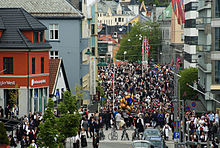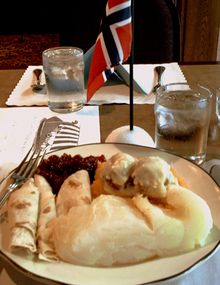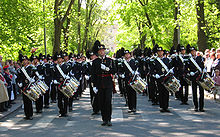- Norwegian Constitution Day
-
Constitution Day 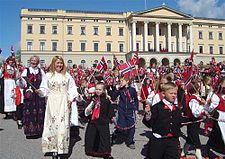
Children's parade in front of the Royal Palace, OsloAlso called Syttende mai or Syttande mai (May 17) Observed by Norwegians Type National Significance Celebrating the signing of the Norwegian Constitution in Eidsvoll, May 17, 1814. Date May 17 Celebrations Parades, flags Related to Constitution of Norway Norwegian Constitution Day is the National Day of Norway and is an official national holiday observed on May 17 each year. Among Norwegians, the day is referred to simply as syttende mai or syttande mai (both meaning May Seventeenth), Nasjonaldagen (The National Day) or Grunnlovsdagen (The Constitution Day), although the latter is less frequent.
Contents
Historical background
 17th of May 1893 by Norwegian painter Christian Krohg (1852–1925). Note that the flag does not have the Union badge of Norway and Sweden, the so called sildesalaten (Herring salad).
17th of May 1893 by Norwegian painter Christian Krohg (1852–1925). Note that the flag does not have the Union badge of Norway and Sweden, the so called sildesalaten (Herring salad).
The Constitution of Norway was signed at Eidsvoll on May 17 in the year 1814. The constitution declared Norway to be an independent nation.
The celebration of this day began spontaneously among students and others from early on[citation needed]. However, Norway was at that time under Swedish rule (following the Convention of Moss in August 1814) and for some years the King of Sweden and Norway was reluctant[citation needed] to allow the celebrations. For a couple of years in the 1820s, King Karl Johan actually forbade[citation needed] it, as he thought the celebrations a kind of protest and disregard—even revolt—against Swedish sovereignty[citation needed]. The king's attitude changed slightly after the Battle of the Square in 1829, an incident which resulted in such a commotion that the king had to allow it[citation needed]. It was, however, not until 1833, that anyone ventured to hold a public address on behalf of the day. That year, official celebration was initiated by the monument of the late politician Christian Krogh, known to have stopped the king from gaining too much personal power[citation needed]. The address was held by Henrik Wergeland, thoroughly witnessed and accounted for by a Swedish spy, sent by the king himself[citation needed].
After 1864[why?], the day became more established, and the first children's parade was launched in Christiania, in a parade consisting only of boys. This initiative was taken by Bjørnstjerne Bjørnson, although Wergeland made the first known children's parade at Eidsvoll around 1820. It was only in 1899 that girls were allowed to join in the parade for the first time.
By historical coincidence, the Second World War ended in Norway nine days before that year's Constitution Day, on May 8, 1945, when the occupying German forces surrendered. Even if The Liberation Day is an official flag day in Norway, the day is not an official holiday and is not broadly celebrated. Instead a new and broader meaning has been added to the celebration of Norwegian Constitution Day on May 17[citation needed].
The day focused originally on the Norwegian constitution, but after 1905, the focus has been directed also towards the royal family.
Children's parades
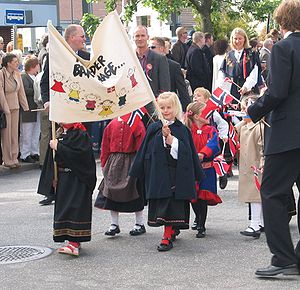 The kindergarten part of a Children's parade. Also notice the use of the Gákti, the traditional clothing of the Sami people.
The kindergarten part of a Children's parade. Also notice the use of the Gákti, the traditional clothing of the Sami people.
A noteworthy aspect of the Norwegian Constitution Day is its very non-military nature. All over Norway, children's parades with an abundance of flags form the central elements of the celebration. Each elementary school district arranges its own parade[1] with marching bands between schools. The parade takes the children through the community, often making stops at homes of senior citizens, war memorials, etc. The longest parade is in Oslo, where some 100,000 people travel to the city centre to participate in the main festivities. This is broadcast on TV every year, with comments on costumes, banners etc., together with local reports from celebrations around the country. The massive Oslo parade includes some 100 schools, marching bands, and passes the royal palace where the royal family greet the people from the main balcony.
Typically a school’s children parade will consist of some senior school children carrying the school’s official banner, followed by a handful of other older children carrying full size Norwegian flags, and the school’s marching band. After the band the rest of the school children follow with hand sized flags, often with the junior forms first, and often behind self made banners for each form or even individual class. Nearby kindergartens may also have been invited to join in. As the parade passes, bystanders often join in behind the official parade, and follow the parade back to the school. Depending on the community, the parade may make stops at particular sites along the route, such as a nursing home or war memorial. In Oslo the parade stops at the Royal Palace while Skaugum, the home of the crown prince, has been a traditional waypoint for parades in Asker.
During the parade a marching band will play and the children will sing lyrics about the celebration of the National Day. The parade concludes with the stationary singing of the national anthem "Ja, vi elsker dette landet" (typically verses 1, 7 and 8), and the royal anthem "Kongesangen".
In addition to flags, people typically wear red, white and blue ribbons. Although a long-standing tradition, it has lately become more popular for men, women, and children to wear traditional outfits, called bunad. The children also make a lot of noise shouting "Hurra!", singing, blowing whistles and shaking rattles.
In addition to children's parades, there are parades for the public, where every citizen is welcome to join in. These are led by marching bands and often local boy scouts and girl guides, local choirs, etc. This takes place in the early morning or in the afternoon, before or after the school's parade.
All parades begin or end with speeches. Both grown-ups and older children are invited to speak. After the parades, there are games for the children, and often a lot of icecream, pop, sweets and hotdogs are consumed.
Russ
 Norwegian constitution day celebration in Bergen, Norway.
Norwegian constitution day celebration in Bergen, Norway.
 Russ girls during the children's parade in Trondheim.
Russ girls during the children's parade in Trondheim.
The graduating class from the Norwegian equivalent of high school - known as russ - has its own celebration on May 17, staying up all night and making the rounds through the community. The russ also have their own parades later in the day, usually around 4 or 5 PM. In this parade, russ will parade through the street with their russcars carrying signs and pickets. They may parody various local and political aspects, although recently this has become less frequent. Russ parades have lately become smaller and smaller due to diligent police discouragement.
Celebration across the country
- In Oslo, children from all the city's schools gather to parade past the Royal Palace, where they and the Royal Family exchange waves and greetings.
- In the municipality of Asker, outside Oslo, the children gather outside the residence of the throne heir at Skaugum Estate in the morning (giving the Prince and his family time to attend the parade in Oslo later in the day).
- Bergen has its own traditions for the parade, including comic troupes, various local organizations, a children's parade, and the unique buekorps.
- In Trondheim, children from all the city's schools parade the streets of Trondheim in the morning. Later in the afternoon, the "Citizens Parade" (Borgertoget) starts. This is a parade where firefighters, sports teams, students associations and other associations are represented.
In addition to the children's parades the streets are filled with young and old, turning out in festive attire, and vendors selling ice cream, hot dogs, and lately, kebabs.
Although May 17 is the National Day, it is an inclusive kind of nationalism. Therefore any foreigner who happens to be there on this day can expect to have a flag thrust into their hand and is welcome to join in with all activities.
Celebration abroad
Syttende Mai is also celebrated in many Norwegian immigrant communities throughout the world, with traditional foods, sometimes including lutefisk. In the United States and Canada, the local lodges of the Sons of Norway often play a central part in organizing the festivities. One major celebration occurs in Petersburg, Alaska also known as "Little Norway". The town is a Norwegian settlement and strongly retains its roots. The festival occurs the weekend closest to May 17 and includes a parade, Leikarring dancers, herring toss, Norwegian pastries such as lefse and even a pack of Vikings and Valkyries.
Another major Syttende Mai celebration occurs in Stoughton, Wisconsin, which is the 2nd largest in the world, and the 1st largest in the U.S. Festivities include canoe racing, two parades, an art fair, a 20-mile run that starts in Madison, Wisconsin, and a great deal of bratwurst consumption. The festival features the Stoughton High School Norwegian Dancers, a group that tours the country showcasing traditional ethnic dances of Scandinavia.[2]
Smaller Syttende Mai celebrations are held in Norwegian-heritage communities throughout western Wisconsin, Minnesota, and elsewhere in the Midwestern United States.[3] Members of Norway's Parliament Storting travel to Chicago to attend a three-day celebration consisting of a concert, banquet and parade hosted by the Norwegian National League.[4] Spring Grove, Minnesota also hosts a 3 day festival on the weekend nearest to Syttende Mai, while nearby Decorah, Iowa, the home of Nordic Fest and the Vesterheim Norwegian-American Museum, also hosts a parade.
Other large celebrations are held in the Ballard, Seattle, Washington neighborhood,[5] Poulsbo, Washington,[6] and Bay Ridge, Brooklyn. Epcot's Norwegian Pavilion in Florida, celebrates Constitution Day with numerous flags around the pavilion, as well as parades around the World Showcase Lagoon.
The Norwegian community in London holds a May 17 celebration each year in Southwark Park. The celebration is attended by a large number of Norwegians abroad, and includes a small parade, a traditional mass in the church, and the selling of traditional Norwegian foods such as Solo and makrell i tomat, and a lot of Norwegian flags for Norwegians who have left theirs at home. The occasional Russ has also attended the parade.
In Orkney, Scotland, 17. May is celebrated by the Orkney Norway Friendship Association in recognition of the islands' strong historic links with Norway.[7]
Stockholm, Sweden, has a big celebration with a parade starting at Engelbrektsplan and ending at Skansen, in which more than 10,000 participate every year. The event includes Stockholm's only dedicated 17. May marching band, Det Norske Korps.[8]
It is also common for Norwegians living abroad to gather and celebrate. In some countries, typically where the population of Norwegian expatriates is small, the Norwegian embassy or the diplomats' spouses arrange the event.
-
Soldiers celebrating the national holiday in Meymaneh, Afghanistan.
Henrik Wergeland
The poet Henrik Wergeland is credited with making Syttande/Syttende mai a celebratory day for the children rather than a day of patriotic pride. Actually, the day demonstrates that the children, i.e. the country's future, are the patriotic pride, if we follow Wergeland's thought. Flags and music dominate the day, and there are few military parades. To commemorate his contribution, the russ in Oslo place an oversized hat on his statue near the Norwegian parliament; the Jewish community place a wreath on his grave in the morning as a tribute to his efforts on their behalf.
Military participation
The Royal Guard performs on the main street of the capital city, Oslo. During the parade, the Guard display their drill and musical skills. The marching band of the Royal Guard also attend the children's parade in central Oslo together with the schools' own marching bands, their black uniforms and impeccable drill being a very popular part of the Oslo parade.
Forsvarets Musikkorps Vestlandet (Norwegian Armed Forces' Music Corps Western Norway), followed by parts of the military defence is participating the parade of Bergen.
An inclusive holiday
The former Norwegian president of parliament Jo Benkow noted that the day has increasingly become a celebration of Norway's growing ethnic diversity.
Several factors have probably contributed to the inclusive nature of the celebration:
- The central position of the children’s parade, including all lower level school children, and therefore also their parents in the celebration.
- The celebration is focused around local schools and their children’s parade.
- The children’s parade reaches outwards, trying to cover as many roads as possible in the local community.
- The low focus on elected government during the celebration. In the capital, for example, the children’s parade passes the left side of the parliament building, and the president of parliament is allowed to wave to the passing parade from a small balcony,[9] but the main focus of the parade is the Royal Castle and the Royal Family. It must also be noted that the office of president of parliament is mainly ceremonial and administrative, often awarded in the later part of a political career. The prime minister and the rest of the ruling government on the other hand have no official duties during the celebrations.
- The virtual lack of any military-centred celebration.
One can add that the day should be regarded as an expression of thankfulness, on behalf of the old values freedom, equality and brotherhood, the ideological basis for the constitution, and also on behalf of the circumstances that led up to the constitution. The aspect of "thanksgiving" in the national celebrations of Norway is easily forgotten in the long span of years from 1814.
See also
- Constitution Day – A list of similar holidays in other countries
- Riksforsamlingen
- Constitution of Norway
Notes
- ^ The Norwegian language has several distinct words for the English term “parade”: “Parade” which refers to a military like parade, and “tog” or "opptog" which refer to people walking in a predefined route just like a train moving along its track. The Norwegian word for "train", "tog", is derived from the Old Norse word for "rope" - indicating a row of people walking in a long line. The word "tog" was used of people walking in procession before the country ever got trains. In Bergen, the parade is known as a "prosesjon" (procession).
- ^ Syttende Mai, stoughtonwi.com
- ^ Syttende Mai in the Midwest, norway.org
- ^ Syttende Mai Parade, nnleague.org
- ^ "Syttende Mai in Seattle". http://www.syttendemaiseattle.com/.
- ^ Viking Fest Carnival, vikingfest.org
- ^ Orkney Norway Friendship Association, orkney.com
- ^ 17. May in Stockholm, Det Norske Korps (Norwegian)
- ^ A funny side-note showing the low focus of elected government is the balcony the president of parliament is using: In the earlier days this was a small, temporary balcony added to one of the windows of the parliament building just before the National Day and removed afterwards. Prior to the parade the president of parliament must have carefully climbed out of the window and onto the balcony, while during the parade itself his mind must have switched between remembering to wave to the children parading and worrying if the balcony would fall down. Today the parliament building has a quite small, but permanent balcony that looks less likely to collapse.
 Norway topics
Norway topicsHistory Geography Law Politics Constitution · Counties · Elections · European Union relations · Foreign relations · Government · Monarchy · Municipalities · Political parties · Prime Minister (List) · Romantic nationalism · Sámi Parliament · ParliamentEconomy Norwegian krone · National Bank · Oslo Stock Exchange · Education · Energy · Media · Tourism · Transport · Companies · WhalingMilitary Symbols Demographics Administrative divisions · Cities · Postal codes · Languages · Religion · Immigration · Norwegians · List of NorwegiansCulture Architecture · Art · Cinema (Actors) · Music (Composers) · Cuisine · Norwegian language · Literature (Writers · Poets) · Bunad · Jul · Constitution Day · Media · Football · Rugby union · Public holidaysCategories:- Norwegian culture
- Norwegian society
- Holidays in Norway
- History of Norway
- May observances
- 1814 in Norway
- 1814 establishments in Norway
- Recurring events established in 1814
- Constitution days
Wikimedia Foundation. 2010.

